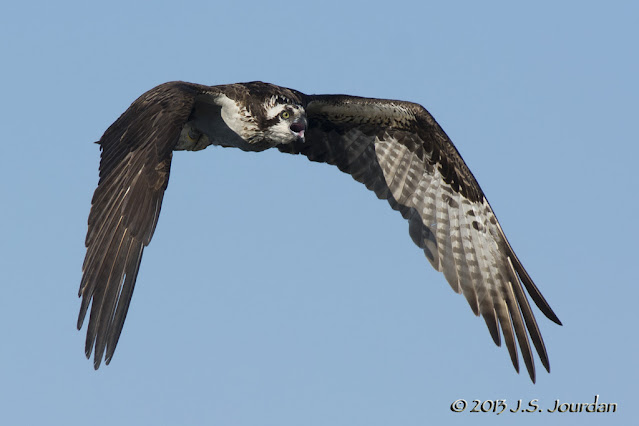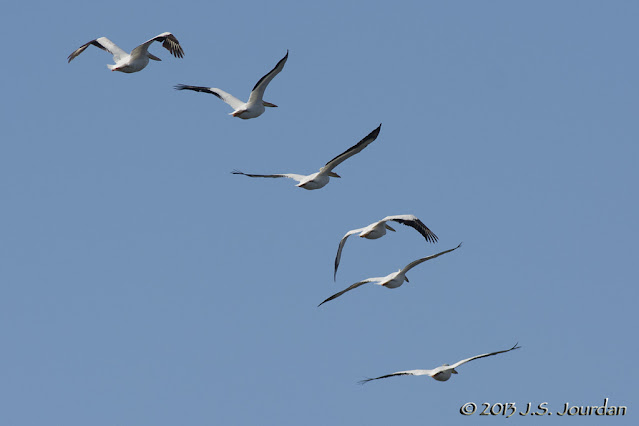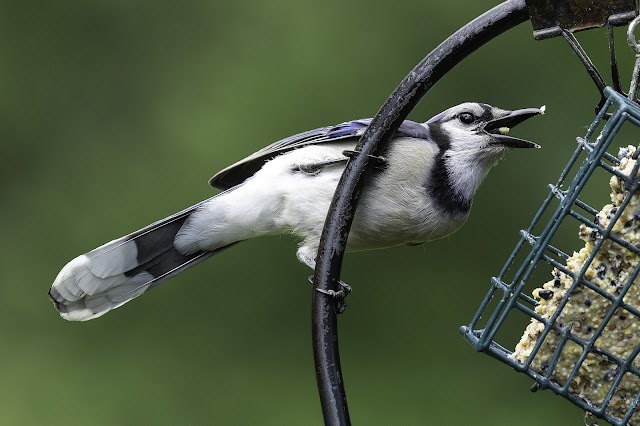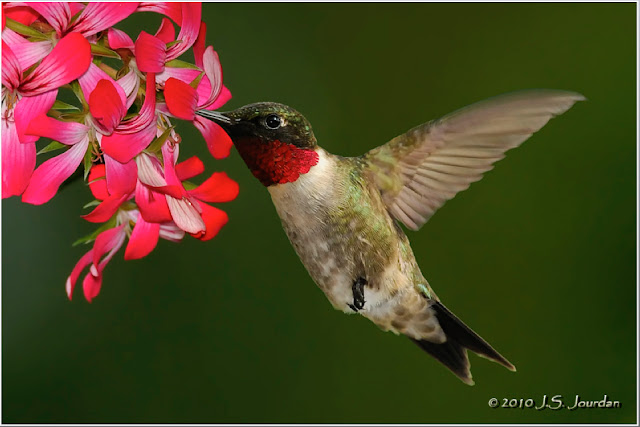The Humphries Unit by Canoe - 26 May 2013
Will arrived promptly at 6:30 am, and we put in. A Northern Rough-winged Swallow was roosting along the shoreline and provided my first pics w/ the D7100 and 300/2.8 VRII from the canoe. An adult Barn Swallow was just a few feet further.
We canoed the west shoreline of the Humphries Unit (well, Will did most of the canoeing while I sat pretty in the front...) working our way northward toward the Middle Causeway. DNR spraying from last fall had left a good portion of the west shoreline dead, but we never appreciated the sheer expanse of brown real estate until we saw it from the canoe. It would take a while before we reached the emergent cattail marsh that is so readily seen from the dike next to Cells 2 - 3. A small mud island along the southwest shoreline held a couple of Semipalmated Plovers, Killdeer, and a cooperative Dunlin that paid little mind to us as we paddled by.
What was most surprising though, is that the cattail marsh is not a continuous expanse of vegetation, rather it is pockets or islands of cattails tightly packed together, with gaps in between large enough to squeeze a canoe through. We were able to maneuver into many small channels and literally lose site of shoreline in all directions.
Muskrat mounds were a popular location for Forster's Tern nests. We spotted several unoccupied nests holding anywhere from 3 - 8 mottled white-brown eggs. We estimated anywhere from 100 - 300 Forster's Terns in this unit alone! Dozens of nests were in sight from the canoe, while dozens more remained hidden farther in the dense vegetation.
One of our goals for the outing was to determine if there was an active colony of nesting Yellow-headed Blackbirds not visible from the dikes along the north (Middle Causeway) and east (Banana) shorelines. It took a while, but we finally started hearing the distinctive honking of territorial males. We spotted several pairs of males actively chasing each other through the islands of cattails, and would later estimate at least 25 Yellow-headed Blackbirds in the Humphries Unit, alone. I managed to grab a few fly-by photos of one male bird, and created this composite shot showing the white wing patches of the bird in flight. Unfortunately we were canoeing into the sun most of the morning, so we figured we get better photo opps on the way back.
With special thanks to Barb Baldinger, Barb Jensen and Sergej Postupalsky, I received this reply from Sergej regarding the female:
Hi Jerry,
I'm tickled pink to have the confirmation that the female I had trapped and uniquely color-banded at the Humphries Unit in 2009 at is still nesting there.
Briefly, her history is as follows:
I had reports that the female at the Humphries Unit had a red band on her left leg, the oldest dating from the OWSEM website in 2006. (I band nestling with the FWS band on the right leg and a single color band on the left leg to identify hatching year. Red was used in 2002). So I was particularly eager to learn where she came from.
On 5/20/09 Zack Cooley took Barb (Jensen) and me to the nest and I succeeded in catching the female. The numbered FWS band (788-44564) showed that she was banded as nestling on 7/10/02 at the Tomahawk Creek Flooding north of Atlanta, MI. I replaced the old red band with a fresh one and added color bands to produce:
black/red on L, FWS/yellow on R. I purposely used bright colors to facilitate re-sightings. Since then I've been eagerly waiting for any reports of re-sightings. That's why your report is especially welcome and useful to my research. Apparently she has lost the red band. It was one of the new Darvic bands sealed with PVC cement. The old band was plastic sealed with acetone.
It appears then that this female has been nesting at this platform site at least since 2006 when she was 4 years old. She is 11 years old now. Ospreys typically start nesting at 3 or 4 years of age. The longevity record for a banded Osprey currently stands at 25 years; the oldest one, a female, in my study was 24 when last seen.
From there we headed to the egret rookery that is so readily seen from the dike next to Cell 3. We were interested in seeing if there were any Snowy or Cattle Egrets nesting that we could not see from the dike. Although we would dip on both species, we counted approximately 300 Black-crowned Night Herons and another 200 Great Egrets nesting on the island. Most of the birds were visible on the backside of the island not visible from the dikes. Of special interest were the flocks of over 250 Wood Ducks that were using the island as a roosting location!
While circling the island rookery Will spotted a flock of seven American White Pelicans flying in the extreme northeast corner of the unit. They circled several times before flying right past us and on toward Cell3 / Lake Erie. Once we got a count of the birds in the rookery we headed to the east shoreline at the south end of Cell 3 to look for the pelicans.
We did not find them, so we walked up to the mudflats of Cell 3 to look for shorebirds. We would only find a handful of Dunlin and a single Semipalmated Sandpiper, otherwise Cell 3 was largely void of shorebirds.
We half-expected to find some Whimbrels in the vicinity, but failed to do so. Incidentally, we would hear reports of Whimbrel flocks flying toward Lake Erie / Toronto from West Virginia, so we expected that the big Whimbrel flight near Pt. Mouillee would occur in the next day or so...
Satisfied that we had covered enough water for the morning, we canoed back to Roberts Rd. and called it a day. Though the Humphries Unit is a large body of water, one cannot fully appreciate the amount of 'hidden' habitat that is available in the unit. Unless you explore by water, much of it remains hidden from view of the dikes lining the east and north shorelines.
Many thanks to Will Weber for the opportunity to explore the hidden portions of the marsh by canoe!
Pte. Mouillee SGA (permit required Sep 1-Dec 15), Monroe, Michigan, US
May 26, 2013 6:30 AM - 11:30 AM
Protocol: Traveling
4.0 mile(s)
Checklist Comments: Canoe Exploration of Humphries (Lead) Unit of Point Mouillee SGA with Jerry Jourdan
43 species
Canada Goose (Branta canadensis) 250
Mute Swan (Cygnus olor) 16
Wood Duck (Aix sponsa) 250 Large flock of males and females near heron rookery island. Surprised to see so many as no apparent nesting habitat nearby. Generally, pairs and groups of up to six were lurking throughout the areas of patchy cattail, no trees necessary! From the dike, I would have likely seen only 6-8 birds.
Blue-winged Teal (Spatula discors) 2
Gadwall (Mareca strepera) 4
Mallard (Anas platyrhynchos) 50
Redhead (Aythya americana) 45
Lesser Scaup (Aythya affinis) 1
Ruddy Duck (Oxyura jamaicensis) 8
Ring-necked Pheasant (Phasianus colchicus) 1
Pied-billed Grebe (Podilymbus podiceps) 25 This seems to few given how common the birds has seemed in the past. No nests found
Sora (Porzana carolina) 1
Common Gallinule (Gallinula galeata) 2
American Coot (Red-shielded) (Fulica americana (Red-shielded)) 30
Killdeer (Charadrius vociferus) 3
Semipalmated Plover (Charadrius semipalmatus) 2
Spotted Sandpiper (Actitis macularius) 2
Lesser Yellowlegs (Tringa flavipes) 1
Willet (Tringa semipalmata) 1 Single bird flying over Lead Unit about 7:15 AM. Called loudly and large bill, size and broad wing stripe noted. Probably a late migrant.
Dunlin (Calidris alpina) 4
Semipalmated Sandpiper (Calidris pusilla) 2
Caspian Tern (Hydroprogne caspia) 6
Forster's Tern (Sterna forsteri) 300 At least three main colony areas in Lead Unit. Noted several nests on muskrat houses. Many birds diving at us an great amount of screaming. Up to 120 birds in the air in one place at one time as we paddled through colony area. Ideal habitate seemed to be patchy cattails with dense clumps and open areas with closely spaced muskrat houses. No young in nests yet.
Double-crested Cormorant (Nannopterum auritum) 120
American White Pelican (Pelecanus erythrorhynchos) 7 Noted flying over Lead Unit as one flock one hour later noted a flock of 3 in a different area, but may have been from same first group. Did not see them land. Did not land in Cell 3
Black-crowned Night Heron (Nycticorax nycticorax) 300 Large colony in active breeding stage. Estimate based upon count of adults in tree and bushes, not young.Possible that the colony is larager as we did not get close enough to detect all nests and incubating birds. Most of these birds are not visilble from middle causewy or Banana Dike.
Green Heron (Butorides virescens) 2
Great Egret (Ardea alba) 220
Great Blue Heron (Ardea herodias) 12
Osprey (Pandion haliaetus) 2 With special thanks to Barb Baldinger, Barb Jensen and Sergej Postupalsky, I received this reply from Sergej regarding the female:
Hi Jerry,
I'm tickled pink to have the confirmation that the female I had trapped and uniquely color-banded at the Humphries Unit in 2009 at is still nesting there.
Briefly, her history is as follows:
I had reports that the female at the Humphries Unit had a red band on her left leg, the oldest dating from the OWSEM website in 2006. (I band nestling with the FWS band on the right leg and a single color band on the left leg to identify hatching year. Red was used in 2002). So I was particularly eager to learn where she came from.
On 5/20/09 Zack Cooley took Barb (Jensen) and me to the nest and I succeeded in catching the female. The numbered FWS band (788-44564) showed that she was banded as nestling on 7/10/02 at the Tomahawk Creek Flooding north of Atlanta, MI. I replaced the old red band with a fresh one and added color bands to produce:
black/red on L, FWS/yellow on R. I purposely used bright colors to facilitate re-sightings. Since then I've been eagerly waiting for any reports of re-sightings. That's why your report is especially welcome and useful to my research. Apparently she has lost the red band. It was one of the new Darvic bands sealed with PVC cement. The old band was plastic sealed with acetone.
It appears then that this female has been nesting at this platform site at least since 2006 when she was 4 years old. She is 11 years old now. Ospreys typically start nesting at 3 or 4 years of age. The longevity record for a banded Osprey currently stands at 25 years; the oldest one, a female, in my study was 24 when last seen.
Bald Eagle (Haliaeetus leucocephalus) 1
Belted Kingfisher (Megaceryle alcyon) 2
Eastern Kingbird (Tyrannus tyrannus) 4
Tree Swallow (Tachycineta bicolor) 35
Northern Rough-winged Swallow (Stelgidopteryx serripennis) 2
Barn Swallow (Hirundo rustica) 50
Marsh Wren (Cistothorus palustris) 15 These were singing birds seemingly randomly distributed through the Unit. I expected more birds and have heard many more in the same area from the dike alone in the same area in previous years.
Swamp Sparrow (Melospiza georgiana) 3
Yellow-headed Blackbird (Xanthocephalus xanthocephalus) 25 Several obsaervations of territorial males chasing rival. Calling heard in several areas. Many males seen and females presumed incubating. Number noted includes birds heard calling and visually observed. Most of the birds we saw would only be seen coincidentally from dikes.
Baltimore Oriole (Icterus galbula) 1
Red-winged Blackbird (Agelaius phoeniceus) 400
Yellow Warbler (Setophaga petechia) 4
Northern Cardinal (Cardinalis cardinalis) 1
View this checklist online at https://ebird.org/checklist/S1
This report was generated automatically by eBird v3 (https://ebird.org/home)
Many thanks to Will Weber for the opportunity to explore the hidden portions of the marsh by canoe!
Pte. Mouillee SGA (permit required Sep 1-Dec 15), Monroe, Michigan, US
May 26, 2013 6:30 AM - 11:30 AM
Protocol: Traveling
4.0 mile(s)
Checklist Comments: Canoe Exploration of Humphries (Lead) Unit of Point Mouillee SGA with Jerry Jourdan
43 species
Canada Goose (Branta canadensis) 250
Mute Swan (Cygnus olor) 16
Wood Duck (Aix sponsa) 250 Large flock of males and females near heron rookery island. Surprised to see so many as no apparent nesting habitat nearby. Generally, pairs and groups of up to six were lurking throughout the areas of patchy cattail, no trees necessary! From the dike, I would have likely seen only 6-8 birds.
Blue-winged Teal (Spatula discors) 2
Gadwall (Mareca strepera) 4
Mallard (Anas platyrhynchos) 50
Redhead (Aythya americana) 45
Lesser Scaup (Aythya affinis) 1
Ruddy Duck (Oxyura jamaicensis) 8
Ring-necked Pheasant (Phasianus colchicus) 1
Pied-billed Grebe (Podilymbus podiceps) 25 This seems to few given how common the birds has seemed in the past. No nests found
Sora (Porzana carolina) 1
Common Gallinule (Gallinula galeata) 2
American Coot (Red-shielded) (Fulica americana (Red-shielded)) 30
Killdeer (Charadrius vociferus) 3
Semipalmated Plover (Charadrius semipalmatus) 2
Spotted Sandpiper (Actitis macularius) 2
Lesser Yellowlegs (Tringa flavipes) 1
Willet (Tringa semipalmata) 1 Single bird flying over Lead Unit about 7:15 AM. Called loudly and large bill, size and broad wing stripe noted. Probably a late migrant.
Dunlin (Calidris alpina) 4
Semipalmated Sandpiper (Calidris pusilla) 2
Caspian Tern (Hydroprogne caspia) 6
Forster's Tern (Sterna forsteri) 300 At least three main colony areas in Lead Unit. Noted several nests on muskrat houses. Many birds diving at us an great amount of screaming. Up to 120 birds in the air in one place at one time as we paddled through colony area. Ideal habitate seemed to be patchy cattails with dense clumps and open areas with closely spaced muskrat houses. No young in nests yet.
Double-crested Cormorant (Nannopterum auritum) 120
American White Pelican (Pelecanus erythrorhynchos) 7 Noted flying over Lead Unit as one flock one hour later noted a flock of 3 in a different area, but may have been from same first group. Did not see them land. Did not land in Cell 3
Black-crowned Night Heron (Nycticorax nycticorax) 300 Large colony in active breeding stage. Estimate based upon count of adults in tree and bushes, not young.Possible that the colony is larager as we did not get close enough to detect all nests and incubating birds. Most of these birds are not visilble from middle causewy or Banana Dike.
Green Heron (Butorides virescens) 2
Great Egret (Ardea alba) 220
Great Blue Heron (Ardea herodias) 12
Osprey (Pandion haliaetus) 2 With special thanks to Barb Baldinger, Barb Jensen and Sergej Postupalsky, I received this reply from Sergej regarding the female:
Hi Jerry,
I'm tickled pink to have the confirmation that the female I had trapped and uniquely color-banded at the Humphries Unit in 2009 at is still nesting there.
Briefly, her history is as follows:
I had reports that the female at the Humphries Unit had a red band on her left leg, the oldest dating from the OWSEM website in 2006. (I band nestling with the FWS band on the right leg and a single color band on the left leg to identify hatching year. Red was used in 2002). So I was particularly eager to learn where she came from.
On 5/20/09 Zack Cooley took Barb (Jensen) and me to the nest and I succeeded in catching the female. The numbered FWS band (788-44564) showed that she was banded as nestling on 7/10/02 at the Tomahawk Creek Flooding north of Atlanta, MI. I replaced the old red band with a fresh one and added color bands to produce:
black/red on L, FWS/yellow on R. I purposely used bright colors to facilitate re-sightings. Since then I've been eagerly waiting for any reports of re-sightings. That's why your report is especially welcome and useful to my research. Apparently she has lost the red band. It was one of the new Darvic bands sealed with PVC cement. The old band was plastic sealed with acetone.
It appears then that this female has been nesting at this platform site at least since 2006 when she was 4 years old. She is 11 years old now. Ospreys typically start nesting at 3 or 4 years of age. The longevity record for a banded Osprey currently stands at 25 years; the oldest one, a female, in my study was 24 when last seen.
Bald Eagle (Haliaeetus leucocephalus) 1
Belted Kingfisher (Megaceryle alcyon) 2
Eastern Kingbird (Tyrannus tyrannus) 4
Tree Swallow (Tachycineta bicolor) 35
Northern Rough-winged Swallow (Stelgidopteryx serripennis) 2
Barn Swallow (Hirundo rustica) 50
Marsh Wren (Cistothorus palustris) 15 These were singing birds seemingly randomly distributed through the Unit. I expected more birds and have heard many more in the same area from the dike alone in the same area in previous years.
Swamp Sparrow (Melospiza georgiana) 3
Yellow-headed Blackbird (Xanthocephalus xanthocephalus) 25 Several obsaervations of territorial males chasing rival. Calling heard in several areas. Many males seen and females presumed incubating. Number noted includes birds heard calling and visually observed. Most of the birds we saw would only be seen coincidentally from dikes.
Baltimore Oriole (Icterus galbula) 1
Red-winged Blackbird (Agelaius phoeniceus) 400
Yellow Warbler (Setophaga petechia) 4
Northern Cardinal (Cardinalis cardinalis) 1
View this checklist online at https://ebird.org/checklist/S1
This report was generated automatically by eBird v3 (https://ebird.org/home)







































